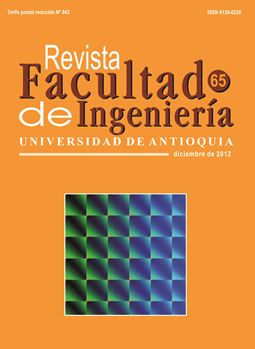Assessment of severity of a flat at the rolling surface of the railway wheel
DOI:
https://doi.org/10.17533/udea.redin.14228Keywords:
vibration analysis, rail transportation, rail wheel flatAbstract
The presence of planes, although incipient, on the rolling surface is the cause of a rapid deterioration of the wheel-rail contact with the consequences that this entails both for the environment and for the rolling stock itself. That is why the detection of these planes, before they become apparent due to their consequences, is of great interest and reason for study. This paper presents some of the results obtained in an extensive measurement campaign carried out on a line of the Barcelona Metropolitan Railway. The vibration of the rail at the passage of the wheels is detected by an accelerometer located at the foot of the rail and the exact moment when the wheels pass through the section where the accelerometer is located is determined by the shear deformation of the rail web. Different indicators are proposed and applied to the experimental records to quantify the severity of the planes. One of the aspects analyzed from the experimental data is the variation in the energy peak of the vibration detected as a function of the distance between the section where a plane hits the road and the accelerometer. This peak must be normalized to correctly establish the severity of the plane.
Downloads
References
E. Flórez. Detección y caracterización de planos en la superficie de rodadura de las ruedas de un tren mediante el análisis de la vibración generada por el contacto rueda-carril. Tesis Doctoral. Univ. Politécnica de Catalunya. Barcelona, España. 2009. pp. 58-67.
B. Molina. Estudio de la creación, desarrollo y método de detección de grietas en ruedas ferroviarias. Tesis Doctoral. Univ. Politécnica de Madrid. Madrid, España. 2006. pp. 36-42.
S. Lechowicz, C. Hunt. Monitoring and managing wheel condition and loading. International Symposium Transportation Recorders. Arlington-Virginia (USA). 1999. pp. 205-239.
J. Melke, S. Kraemer. “Diagnostic Methods in the Control of Railwal Noise and Vibration”. Journal of Sound and Vibration. Vol. 87. 1983. pp. 377-386. DOI: https://doi.org/10.1016/0022-460X(83)90577-1
M. Bocciolone, A. Caprioli, A. Cigada, A. Collina. “A measurement system for quick rail inspection and effect track maintenance strategy”. Mechanical System and Signal Processing. Vol. 21. 2007. pp. 1242-1254. DOI: https://doi.org/10.1016/j.ymssp.2006.02.007
M. Lee, W. Chui. “Determination of railway vertical wheel impact magnitudes”. Field trials, Structural Health Monitoring: An International Journal. Vol. 3. 2007. pp. 49-65. DOI: https://doi.org/10.1177/1475921707072063
M. Lee, W. Chiu. “A comparative study on impact force prediction on a railway track-like structure”. Structural Health Monitoring: An International Journal. Vol. 12. 2005. pp. 355-76. DOI: https://doi.org/10.1177/1475921705057976
E. Flórez, S. Cardona, L. Jordi. Uso de la STFT y la CWT en el análisis de vibraciones para detectar y caracterizar la presencia de un defecto en la superficie de las ruedas de un tren. Congreso Iberoamericano de Ingeniería Mecánica. Las Palmas de Gran Canaria. España. 2009. pp. 55-75.
D. Thompson. “Experimental analysis of wave propagation in railway tracks”. J. Sound Vib. Vol. 5. 1997. pp. 867-888. DOI: https://doi.org/10.1006/jsvi.1997.0903
S. Mallat. A wavelet tour of signal processing, Academic Press, London, UK, 1999, pp.69-72 DOI: https://doi.org/10.1016/B978-012466606-1/50008-8
I. Daubechies, Ten Lectures on Wavelets. Society for Industrial and Applied Mathematics. Philadelphia, USA. 1992, pp. 357 DOI: https://doi.org/10.1137/1.9781611970104
L. Cohen, “Time-Frecuency Analysis”, Prentice Hall PTR. New Jersey, USA. 1995. pp. 44-52
P. W. Tse, W. Yang, H. Tam. “Machine Fault Diagnosis Through an Effective Exact Wavelet Analysis”, Journal of Sound and Vibration. Vol. 277. 2004. pp. 1005-1024 DOI: https://doi.org/10.1016/j.jsv.2003.09.031
H. Zheng, Z. Li, X. Chen. “Gear Fault Diagnosis Based on Continuous Wavelet Transform”, Mechanical Systems and Signal Processing. Vol. 16. 2002. pp. 447- 457 DOI: https://doi.org/10.1006/mssp.2002.1482
J. Wu, J. Chen. “Continuous Wavelet Transform Technique for Fault Signal Diagnosis of Internal Combustion Engines”. NDT & E International. Vol. 39. 2006. pp. 304-311 DOI: https://doi.org/10.1016/j.ndteint.2005.09.002
Downloads
Published
How to Cite
Issue
Section
License
Copyright (c) 2018 Revista Facultad de Ingeniería

This work is licensed under a Creative Commons Attribution-NonCommercial-ShareAlike 4.0 International License.
Revista Facultad de Ingeniería, Universidad de Antioquia is licensed under the Creative Commons Attribution BY-NC-SA 4.0 license. https://creativecommons.org/licenses/by-nc-sa/4.0/deed.en
You are free to:
Share — copy and redistribute the material in any medium or format
Adapt — remix, transform, and build upon the material
Under the following terms:
Attribution — You must give appropriate credit, provide a link to the license, and indicate if changes were made. You may do so in any reasonable manner, but not in any way that suggests the licensor endorses you or your use.
NonCommercial — You may not use the material for commercial purposes.
ShareAlike — If you remix, transform, or build upon the material, you must distribute your contributions under the same license as the original.
The material published in the journal can be distributed, copied and exhibited by third parties if the respective credits are given to the journal. No commercial benefit can be obtained and derivative works must be under the same license terms as the original work.










 Twitter
Twitter